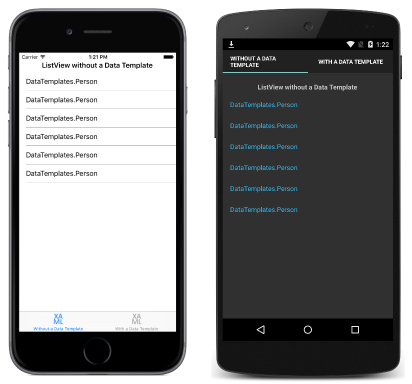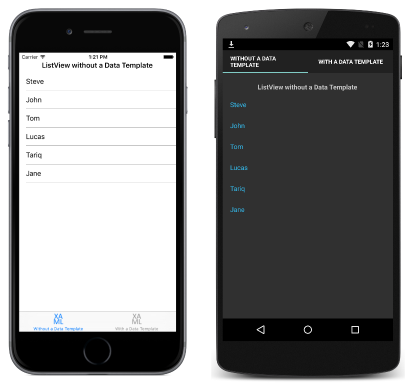Introduction to Xamarin.Forms Data Templates
Xamarin.Forms data templates provide the ability to define the presentation of data on supported controls. This article provides an introduction to data templates, examining why they are necessary.
Consider a ListView that displays a collection of Person objects. The following code example shows the definition of the Person class:
public class Person
{
public string Name { get; set; }
public int Age { get; set; }
public string Location { get; set; }
}
The Person class defines Name, Age, and Location properties, which can be set when a Person object is created. The ListView is used to display the collection of Person objects, as shown in the following XAML code example:
<ContentPage xmlns="http://xamarin.com/schemas/2014/forms"
xmlns:x="http://schemas.microsoft.com/winfx/2009/xaml"
xmlns:local="clr-namespace:DataTemplates"
...>
<StackLayout Margin="20">
...
<ListView Margin="0,20,0,0">
<ListView.ItemsSource>
<x:Array Type="{x:Type local:Person}">
<local:Person Name="Steve" Age="21" Location="USA" />
<local:Person Name="John" Age="37" Location="USA" />
<local:Person Name="Tom" Age="42" Location="UK" />
<local:Person Name="Lucas" Age="29" Location="Germany" />
<local:Person Name="Tariq" Age="39" Location="UK" />
<local:Person Name="Jane" Age="30" Location="USA" />
</x:Array>
</ListView.ItemsSource>
</ListView>
</StackLayout>
</ContentPage>
Items are added to the ListView in XAML by initializing the ItemsSource property from an array of Person instances.
Note
Note that the x:Array element requires a Type attribute indicating the type of the items in the array.
The equivalent C# page is shown in the following code example, which initializes the ItemsSource property to a List of Person instances:
public WithoutDataTemplatePageCS()
{
...
var people = new List<Person>
{
new Person { Name = "Steve", Age = 21, Location = "USA" },
new Person { Name = "John", Age = 37, Location = "USA" },
new Person { Name = "Tom", Age = 42, Location = "UK" },
new Person { Name = "Lucas", Age = 29, Location = "Germany" },
new Person { Name = "Tariq", Age = 39, Location = "UK" },
new Person { Name = "Jane", Age = 30, Location = "USA" }
};
Content = new StackLayout
{
Margin = new Thickness(20),
Children = {
...
new ListView { ItemsSource = people, Margin = new Thickness(0, 20, 0, 0) }
}
};
}
The ListView calls ToString when displaying the objects in the collection. Because there is no Person.ToString override, ToString returns the type name of each object, as shown in the following screenshots:

The Person object can override the ToString method to display meaningful data, as shown in the following code example:
public class Person
{
...
public override string ToString ()
{
return Name;
}
}
This results in the ListView displaying the Person.Name property value for each object in the collection, as shown in the following screenshots:

The Person.ToString override could return a formatted string consisting of the Name, Age, and Location properties. However, this approach offers only a limited control over the appearance of each item of data. For more flexibility, a DataTemplate can be created that defines the appearance of the data.
Creating a DataTemplate
A DataTemplate is used to specify the appearance of data, and typically uses data binding to display data. Its common usage scenario is when displaying data from a collection of objects in a ListView. For example, when a ListView is bound to a collection of Person objects, the ListView.ItemTemplate property will be set to a DataTemplate that defines the appearance of each Person object in the ListView. The DataTemplate will contain elements that bind to property values of each Person object. For more information about data binding, see Data Binding Basics.
A DataTemplate that's placed as a direct child of the properties listed above is known as an inline template. Alternatively, a DataTemplate can be defined as a control-level, page-level, or application-level resource. Choosing where to define a DataTemplate impacts where it can be used:
- A
DataTemplatedefined at the control level can only be applied to the control. - A
DataTemplatedefined at the page level can be applied to multiple valid controls on the page. - A
DataTemplatedefined at the application level can be applied to valid controls throughout the application.
Data templates lower in the view hierarchy take precedence over those defined higher up when they share x:Key attributes. For example, an application-level data template will be overridden by a page-level data template, and a page-level data template will be overridden by a control-level data template, or an inline data template.